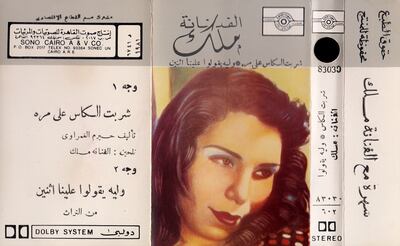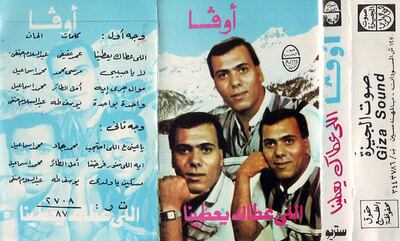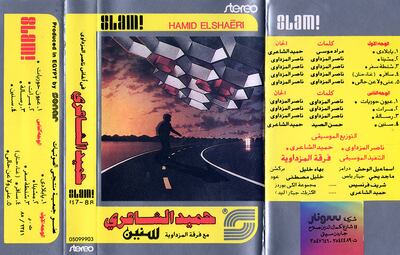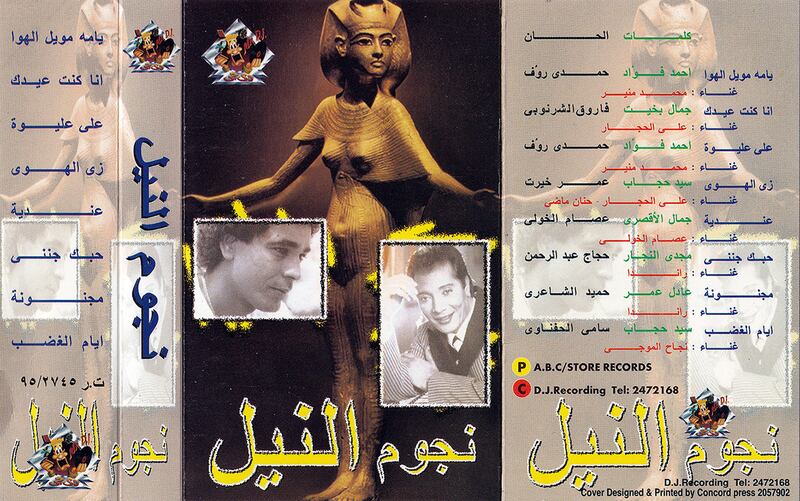For those who remember buying them, cassette tapes were akin to holding magic in one’s hands.
Cassette tapes, housed in small plastic containers and wrapped in elaborately decorated album artwork, offered a gateway into another reality in a time before compact discs, streaming services and social media. With one push of a tape player's chunky button, our most intimate feelings and past experiences came alive through the songs we loved.
For Egyptian visual artist Amr Hamid, the founder and curator of the Egyptian Cassette Archive — an extensive collection of cassette album covers — tapes signified an important piece of culture, the preservation of which became his obsession.
Hamid, an avid music fan, was born in the 1980s, during the heyday of cassettes. He grew up collecting his favourite albums on tape.
“It was the technology of the age, it was how we listened to music. I never imagined it would go out of style so quickly,” he tells The National.

In 2004, while studying fine arts in Luxor, he stumbled upon a cassette market in the tourist town. As he browsed the thousands of albums strewn about at the market, he recalls not recognising a single one. The salesman told Hamid the market sold music only by recording artists from the city and its neighbouring Upper Egyptian provinces.
“I found a whole new world of music by Upper Egyptian artists, really beautiful music that we northerners had never and most probably would never hear of,” says Hamid, who now lives in Sweden. “When I spoke with a local recording veteran in Luxor, he told me that each region in Egypt was full of its own largely obscure albums, known and loved in that region, despite being mostly unheard of anywhere else.”
Hamid was equally struck by the variety of aesthetic styles used in the artwork of the albums he found, some of which were over the top and others more simple.

“Each tape had its own artwork, sometimes they were elaborate and colourful and other times the designs were clean and practical,” Hamid says.
He began to understand that cassette tapes had spawned a cultural revolution in many parts of Egypt, because they made recording much more accessible than it had been in the past, when vinyl records were the only way to preserve sound.
“Cassettes allowed infringed Egyptian subcultures, which the mainstream was not interested in preserving, to be documented. Each place has its own stars whose songs are widely known in each province,” Hamid says.
During his one-year stint in Luxor, he compiled a large and varied collection of recordings by local talent.
But, as the years went by, tapes made way for CDs, which in turn made way for streaming platforms. Hamid’s tape collection was forgotten, left in a pile to gather dust in a corner of his home.

It was not until 2016 when he was moving to a new home that Hamid found a box full of his old tapes. It had been almost a decade since he last thought about them, so he saw them in an entirely new light.
“When I was in Luxor, I was really young and my eye was inexperienced, but after spending 12 years as a visual artist, during which I developed my aesthetic, I saw the tapes from a whole other perspective. They were kitsch art gold,” Hamid says.
It was then that he decided to launch his beloved archive, which now, five years after he began it, comprises more than 5,000 album artworks, the oldest of which dates back to the early ‘70s.
In 2020, Hamid launched an Instagram page dedicated to exhibiting his archive.
“The purpose of this archive is to document the artistic contributions of the many forgotten Egyptians who worked on these designs and acknowledge them. It has also taken an academic turn, because when you look at the artworks I collected, you can trace the evolution of design through them."

He finds one aspect of the archive particularly interesting, he says, and that is the use of Arabic calligraphy in the album covers, and how it changed over the years to fit more modern design aesthetics.
“Egypt is really behind when it comes to documenting its people’s artistic contributions,” Hamid says. “More people need to start preserving the culture more effectively.”
In Hamid’s mind, the archive is a project that he will keep growing throughout his life.
“These artists who made these albums deserve to be seen and recognised by modern audiences,” he says. “They have had an undeniable stamp on modern design tastes in Egypt.”
As part of the documentation process, Hamid has tried to get in touch with the artists who worked on the designs he was archiving, if only to get first-hand accounts of what it felt like to witness the beginnings of tape artwork in Egypt.
“I managed to track down a few of them. I learnt that many of them had died, but I got in touch with their children and sometimes their grandkids. Some of them knew about their ancestor’s work, but sometimes I found that I was telling them stories about their own family that they hadn’t heard before.”







